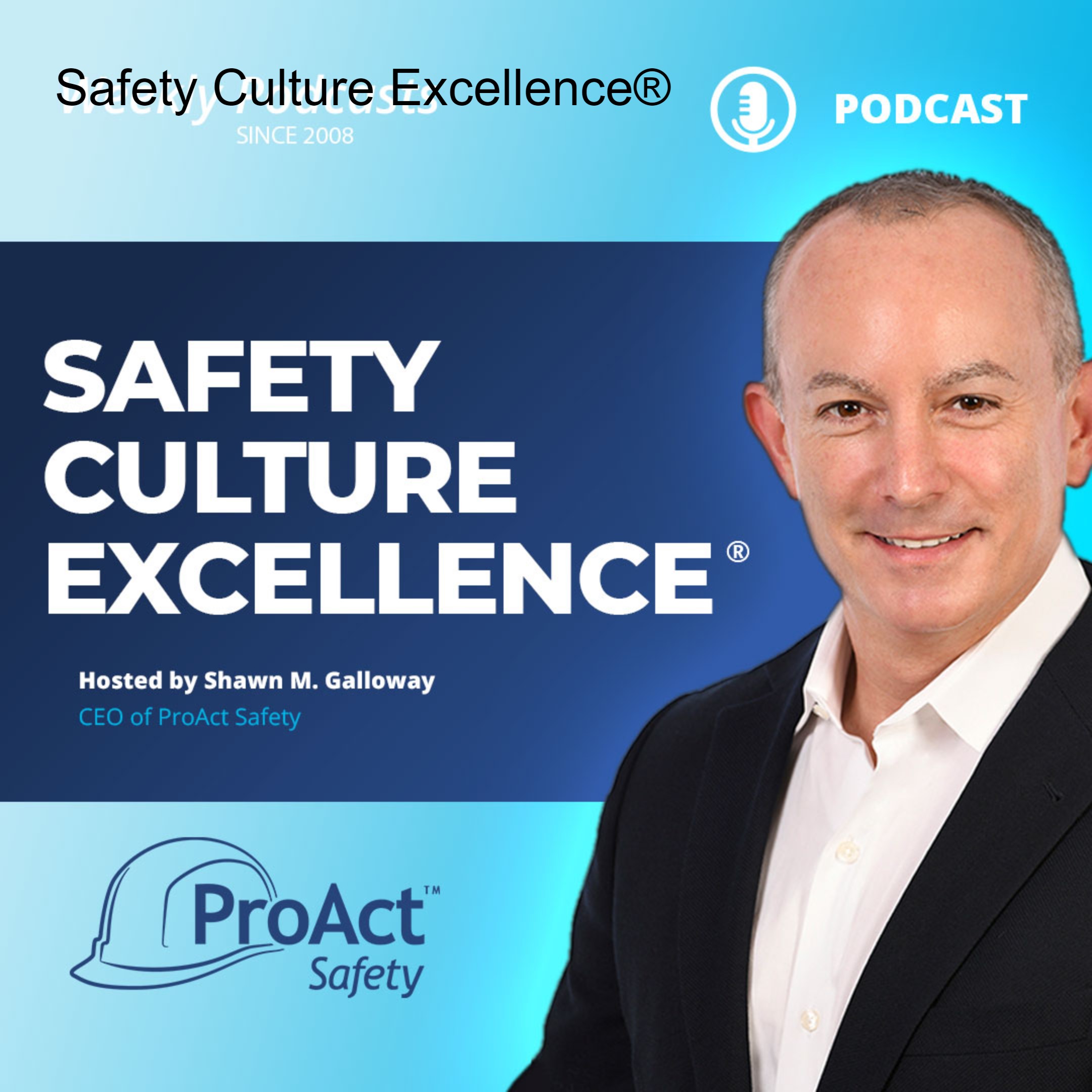Episodes
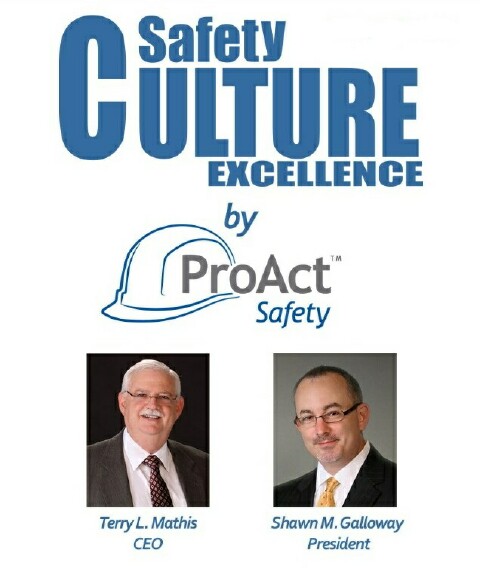
Wednesday Sep 17, 2014
Working In Safety vs. Working on Safety
Wednesday Sep 17, 2014
Wednesday Sep 17, 2014
A business unit manager who was frustrated with a bottleneck in his operations took over a job for several hours from an operator to speed up production. His regional manager walked in and found him there and asked what he was doing. When he explained that he was doing the job of an operator, his boss asked him, “While you are doing that, who is running the unit?” He was working “IN” his unit and not “ON” it.
Many safety professionals are entirely too bogged down with day-to-day busywork to work “on” safety. Others choose to roll up their sleeves and jump in rather than to stand back and strategically evaluate what really needs to be done. Even corporate safety leaders often choose to do work rather than to manage safety strategically. The net result is that many safety efforts are strategy-less, leaderless balls of energy being hurled at the big problem of accidents. The underlying premise is that somehow more effort will win the day.
Often what is needed is not more but better effort. Better effort is accomplished strategically. When everyone is putting forth effort for the sake of effort and no one is working on strategy, that just doesn’t happen.
-Terry L. Mathis
For more insights, visit www.ProActSafety.com
Terry L. Mathis is the founder and CEO of ProAct Safety, an international safety and performance excellence firm. He is known for his dynamic presentations in the fields of behavioral and cultural safety, leadership, and operational performance, and is a regular speaker at ASSE, NSC, and numerous company and industry conferences. EHS Today listed Terry as a Safety Guru in ‘The 50 People Who Most Influenced EHS in 2010, 2011 and 2012-2013. He has been a frequent contributor to industry magazines for over 15 years and is the coauthor of STEPS to Safety Culture Excellence, 2013, WILEY.

Wednesday Sep 10, 2014
Reporting Accident Investigation Findings
Wednesday Sep 10, 2014
Wednesday Sep 10, 2014
When you discuss the findings from recent accident investigations either in safety meetings, stand downs, or via email, what is the focus? Do you determine the root cause and describe the corrective action taken by the organization to avoid repeat injuries? If so, that is good but incomplete. You should also discuss risk awareness techniques to help workers recognize developing at-risk situations and precautions that workers can take to minimize the probability of such accidents.
It is not enough that organizations learn from their accidents; workers should learn as well. When root causes lead to corrective action, risk awareness should also lead to safer behaviors and better hazard recognition. If you only do one of these, you are missing half or more of the potential improvement that could result from your findings. Don’t settle for simply improving conditions or improving behaviors. Always look for opportunities to improve both!
-Terry L. Mathis
For more insights, visit www.ProActSafety.com
Terry L. Mathis is the founder and CEO of ProAct Safety, an international safety and performance excellence firm. He is known for his dynamic presentations in the fields of behavioral and cultural safety, leadership, and operational performance, and is a regular speaker at ASSE, NSC, and numerous company and industry conferences. EHS Today listed Terry as a Safety Guru in ‘The 50 People Who Most Influenced EHS in 2010, 2011 and 2012-2013. He has been a frequent contributor to industry magazines for over 15 years and is the coauthor of STEPS to Safety Culture Excellence, 2013, WILEY.
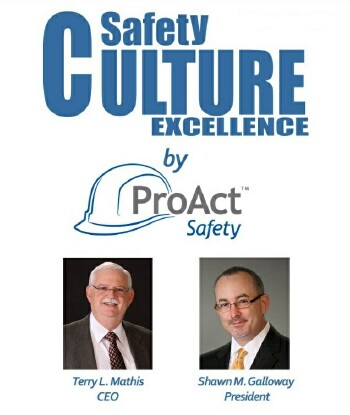
Wednesday Aug 27, 2014
Abstract Safety Leadership
Wednesday Aug 27, 2014
Wednesday Aug 27, 2014
A senior VP asked me to write a safety training program for route drivers and asked what my first step would be. I responded that I would get with a route driver and ride to better understand their safety issues. He seemed astounded and asked me if my education was so incomplete that I could not imagine what they did and direct it to be more “perfect.” This attitude tends to permeate some safety programs and it can do serious damage.
Safety, for workers, is not abstract, it is situational! It involves situational awareness and correct responses to specific dangers. Those who do not understand this are and will continue to be outsiders who may be respected for their positions but not for their knowledge. Such leaders are tolerated, not followed.
Safety cultures are best influenced from within. Abstract leaders are always viewed as outsiders. Outside influences cause resistance, not acceptance. If you want to lead safety and improve your safety culture, get in touch with the reality of your workers and workplace. Talk like someone who has been there and done that and appreciates the challenges of the job. Such actions are not lowering your standards or admitting the limitations of your education, they are living and succeeding in the real world.
-Terry L. Mathis
For more insights, visit www.ProActSafety.com
Terry L. Mathis is the founder and CEO of ProAct Safety, an international safety and performance excellence firm. He is known for his dynamic presentations in the fields of behavioral and cultural safety, leadership, and operational performance, and is a regular speaker at ASSE, NSC, and numerous company and industry conferences. EHS Today listed Terry as a Safety Guru in ‘The 50 People Who Most Influenced EHS in 2010, 2011 and 2012-2013. He has been a frequent contributor to industry magazines for over 15 years and is the coauthor of STEPS to Safety Culture Excellence, 2013, WILEY.
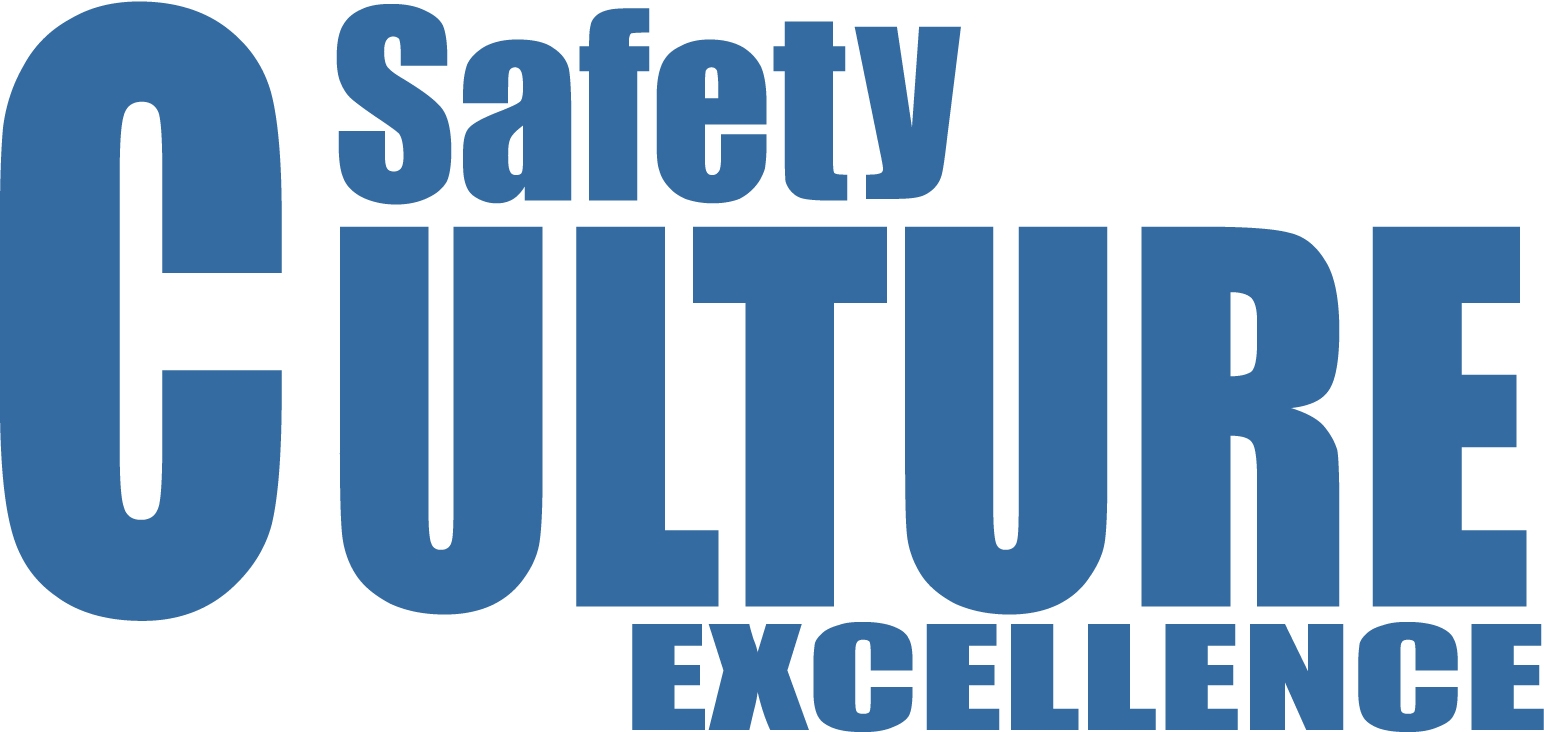
Thursday Aug 07, 2014
Upcoming Free Webinar: 3 Building Blocks For An Excellent Safety Culture
Thursday Aug 07, 2014
Thursday Aug 07, 2014
There is an increasing amount of talk about safety culture with very few real, implementable tactics that outline how to create a culture of safety excellence, and sustain it.
For the first time ever, leveraging the expertise of Canada’s Greg Ford of TalentClick and The United States’ Shawn M. Galloway of ProAct Safety, a free one-of-a-kind webinar will occur on the 24th of September, 2014.
This webinar will be a one a unique and revolutionary exploration into what both industry leaders (with different backgrounds, approaches and client experiences) have found to be the three most important building blocks of safety culture improvement. Safety culture has never been explored, developed, measured and understood like this before.
Greg Ford is the CEO of TalentClick Workforce Solutions. He is passionate about helping organizations eliminate incidents. He is committed to empowering people with “safety self-awareness” so they get home safely at the end of the day. Born in a blue-collar town and raised in a working-class family, Greg has a degree in Psychology and a Masters in Adult Education & Workplace Learning. He is CEO and co-founder of TalentClick and an adjunct professor at Simon Fraser University in Vancouver, Canada.
Greg’s articles have been published in numerous magazines and journals such as Workplace Today, Canadian HR Reporter, People Talk, Mining Weekly, Oil & Gas Monthly and others. He is a member of the Canadian Association of Professional Speakers and has spoken throughout North America.
Shawn M. Galloway is the President of ProAct Safety and coauthor of two books, his latest is STEPS to Safety Culture Excellence. He is one of the top speakers for American Society of Safety Engineers. National Safety Council calls him a “Global safety excellence expert” and a “Top-rated speaker” and listed him in the 2013 Top 40 Rising Stars.
He continues to be recognized by industry magazines as one of the most influential EHS leader and safety excellence expert. In addition to the books, hundreds of podcasts, articles and videos he is also the host of the highly acclaimed weekly podcast series, Safety Culture Excellence and a columnist for several magazines.
I hope you will join us for this exciting event!
Link to event: http://tinyurl.com/pu3axfn

Wednesday Aug 06, 2014
Through the Eyes of the Contractor
Wednesday Aug 06, 2014
Wednesday Aug 06, 2014
How many safety professionals who manage contractor relations have ever been contractors themselves? Is safety different for contractors than it is for regular employees? Anyone asking these questions is thinking but probably does not have the answers. YES! Safety is different for contractors and those who try to manage it as though it were not quickly lose credibility.
That does not mean contractors will not placate them and try to make them happy. It simply means that their directives may be dramatically unrealistic and obviously out of touch with the reality of the task at hand. The sad truth is that safety is not an abstract construct that is universally applicable.
True safety is highly in tune with the realities of the job, the worker and the workplace. Safety guidelines that ignore these realities flash a neon light that says “Out of Touch” and labels the originator of them as a complete outsider who is clueless even if the person in charge. Savvy safety professionals seek out these realities and remain flexible. Remember the old saying, “In theory, there is no difference between theory and practice. In practice, there is!”
-Terry L. Mathis
For more insights, visit www.ProActSafety.com
Terry L. Mathis is the founder and CEO of ProAct Safety, an international safety and performance excellence firm. He is known for his dynamic presentations in the fields of behavioral and cultural safety, leadership, and operational performance, and is a regular speaker at ASSE, NSC, and numerous company and industry conferences. EHS Today listed Terry as a Safety Guru in ‘The 50 People Who Most Influenced EHS in 2010, 2011 and 2012-2013. He has been a frequent contributor to industry magazines for over 15 years and is the coauthor of STEPS to Safety Culture Excellence, 2013, WILEY.

Wednesday Jul 30, 2014
Transformational Leadership in Safety
Wednesday Jul 30, 2014
Wednesday Jul 30, 2014
Safety leaders are regularly looking for ways to improve safety, or are they? All too many leaders would settle for maintaining the status quo or managing to fail a little less this year than last. It is not that they would not like to make a truly transformational improvement in safety. They simply either don’t think it is possible or don’t have a plan to make it happen.
The beginning of a transformation in safety is to quit trying to control workers and start adding value to them. Workers may sometimes be the problem but they are also the solution. Helping workers perform more safely is different than controlling them. The whole terminology of “safety controls” loses its effectiveness when it moves from conditional controls to behavioral controls.
Transformation begins with winning hearts and minds over to safety excellence and providing the support to enable their efforts. Safety becomes a life ambition and not a game that needs rules to keep people from cheating. The hands and feet of workers only need to be controlled when their hearts and minds are not bought in and fully engaged in the safety effort.
-Terry L. Mathis
For more insights, visit www.ProActSafety.com
Terry L. Mathis is the founder and CEO of ProAct Safety, an international safety and performance excellence firm. He is known for his dynamic presentations in the fields of behavioral and cultural safety, leadership, and operational performance, and is a regular speaker at ASSE, NSC, and numerous company and industry conferences. EHS Today listed Terry as a Safety Guru in ‘The 50 People Who Most Influenced EHS in 2010, 2011 and 2012-2013. He has been a frequent contributor to industry magazines for over 15 years and is the coauthor of STEPS to Safety Culture Excellence, 2013, WILEY.

Wednesday Jul 23, 2014
Outsourcing Leadership Training
Wednesday Jul 23, 2014
Wednesday Jul 23, 2014
Today’s economic realities have necessitated a great deal of outsourcing. Organizations are clinging to their core competencies and value potential and hiring out peripheral tasks. In safety, more and more of the training function is being outsourced. This can be a good approach to some types of safety training but is definitely not for others.
Definite YES: Skills training by technical experts is almost always more effective. If the organization cannot justify keeping such an expert onboard full-time, outsourcing makes good sense and is often quite effective.
Definite NO: Training that establishes official management style or organizational philosophy. If you want your supervisors to coach safety or your leaders to stay on message about organizational mission and vision for safety, outside trainers are definitely not the way. Specific skills such as coaching or communications can be taught by outsiders, but the deep-rooted organizationally-specific style training is best done by an insider with recognized ties to the organization and specific information to answer questions on strategy and tactics.
Maybe with Qualifications: Training that is required for regulatory compliance can often be outsourced effectively. The one nuance is that much of this type of training is very generic and may not be easily or directly applied by workers to their specific tasks. Training that is too theoretical may lose its effectiveness if the link between the theory and workplace reality is not clear.
Outsourcing the right training and keeping the right training in-house can be a key to success in safety.
-Terry L. Mathis
For more insights, visit www.ProActSafety.com
Terry L. Mathis is the founder and CEO of ProAct Safety, an international safety and performance excellence firm. He is known for his dynamic presentations in the fields of behavioral and cultural safety, leadership, and operational performance, and is a regular speaker at ASSE, NSC, and numerous company and industry conferences. EHS Today listed Terry as a Safety Guru in ‘The 50 People Who Most Influenced EHS in 2010, 2011 and 2012-2013. He has been a frequent contributor to industry magazines for over 15 years and is the coauthor of STEPS to Safety Culture Excellence, 2013, WILEY.

Wednesday Jul 16, 2014
Culture and Customizing
Wednesday Jul 16, 2014
Wednesday Jul 16, 2014
Some of the old safety programs and processes are still alive and well in certain organizations. When I examine how they have survived so long I almost always find that the program has been modified and customized. The organization is not still doing the process like they were taught, they have “made it their own” over the years using the basic concept(s) but modifying the details.
Another term for customizing might be “culturizing.” When a group of people not only use a methodology but modify it to fit their specific needs and standards, it truly becomes a part of the organizational culture. It is no longer solely the brainchild of the originator, but the adopted child of the group. As it permeates the group it becomes a part of the culture that is shared and handed down.
Such processes never become outdated because they are fluid and the group can evolve them to meet changing needs and challenges. Perhaps it should be the goal of every safety program or process to have this kind of flexibility built in as a sustainability tool. If this were the case, there would likely be fewer flavors of the month and more tools to build strong safety cultures.
-Terry L. Mathis
For more insights, visit www.ProActSafety.com
Terry L. Mathis is the founder and CEO of ProAct Safety, an international safety and performance excellence firm. He is known for his dynamic presentations in the fields of behavioral and cultural safety, leadership, and operational performance, and is a regular speaker at ASSE, NSC, and numerous company and industry conferences. EHS Today listed Terry as a Safety Guru in ‘The 50 People Who Most Influenced EHS in 2010, 2011 and 2012-2013. He has been a frequent contributor to industry magazines for over 15 years and is the coauthor of STEPS to Safety Culture Excellence, 2013, WILEY.

Wednesday Jul 09, 2014
Measuring Safety Culture Maturity: A Better Way
Wednesday Jul 09, 2014
Wednesday Jul 09, 2014
Forget the old ways of measuring safety culture maturity. There is a new, more effective way to measure cultural maturity and it starts with looking at the chemistry.
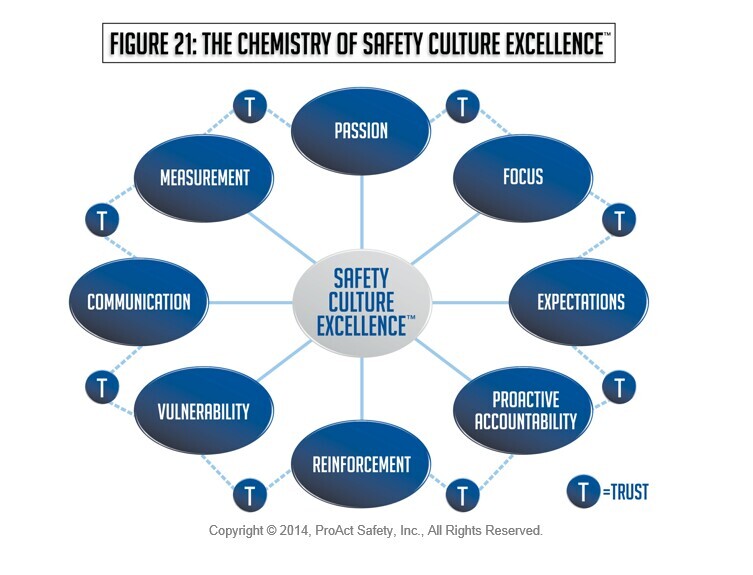
In consulting globally with many of the best in safety performance and culture, nine elements (see the picture with this post) have been identified as most important foci to establish the chemistry which facilitates the necessary climate for a culture of safety excellence to grow. Through consulting engagements and workshops, these nine elements have been successfully leveraged and measured to help organizations identify both their starting point baseline, and also to strategically prioritize which elements to focus on to advance the capabilities of their safety culture.
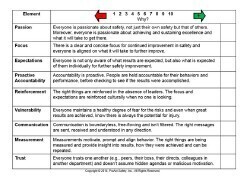
If you have read my work, participated in any of my workshops or keynote presentations or worked with me directly, you will know I work hard to always provide more take-away tools than motivational fluff. If I was able to provide the framework to facilitate the internal dialogue in article format, I would.
To assist you on your journey to safety excellence, I would like to share this tool with you. To obtain a copy for your internal use, send an email to info@proactsafety.com with the subject of Please Send Chemistry of SCE and our staff will respond at our earliest opportunity.
Cultures will always influence the beliefs and behaviors of employees and contractors as they join the group. You can either manage the chemistry, climate and culture, or the results in any area of operational performance will be managed by them. I invite you to start the conversation to strategically enhance the safety aspect of your company culture and measure your progress by contributed value, not just the lowering of injury rates.
-------------------
Shawn M. Galloway is the President and COO of ProAct Safety. He writes (and tweets:@safetyculture) about his work helping organizations in all industries to achieve and sustain excellence in their culture and performance. He resides near Houston, Texas with his wife and three children.

Wednesday Jul 02, 2014
Blue Ocean or Bomb the Island: Innovation vs. Provocation
Wednesday Jul 02, 2014
Wednesday Jul 02, 2014
A controversy has almost always attracted attention. That is why some constantly try to provoke an argument about some aspect of a practice. The idea of questioning the status quo is a legitimate issue, but simply challenging the establishment does not advance the cause. True advancement comes from trying the new, not from simply attacking the old.
There is a parallel between the provocateur and the old dichotomous thinking expressed in the saying, “If it ain’t broke don’t fix it!” The idea that everything fits into either the fixed or broken category is limited, two-dimensional thinking at best. The innovative approach does not categorize ideas or practices, but seeks to advance them. In true innovation, there are not even “best practices” because such thinking might stop future progress. There are better practices that will be replaced by even better practices as our wits sharpen and our organizations embrace transformational thinking.
Blue ocean thinking opens whole new avenues of opportunity for the landlocked. Provocation tends to bomb the island on which we live without discovering a new one.
-Terry L. Mathis
For more insights, visit www.ProActSafety.com
Terry L. Mathis is the founder and CEO of ProAct Safety, an international safety and performance excellence firm. He is known for his dynamic presentations in the fields of behavioral and cultural safety, leadership, and operational performance, and is a regular speaker at ASSE, NSC, and numerous company and industry conferences. EHS Today listed Terry as a Safety Guru in ‘The 50 People Who Most Influenced EHS in 2010, 2011 and 2012-2013. He has been a frequent contributor to industry magazines for over 15 years and is the coauthor of STEPS to Safety Culture Excellence, 2013, WILEY.

